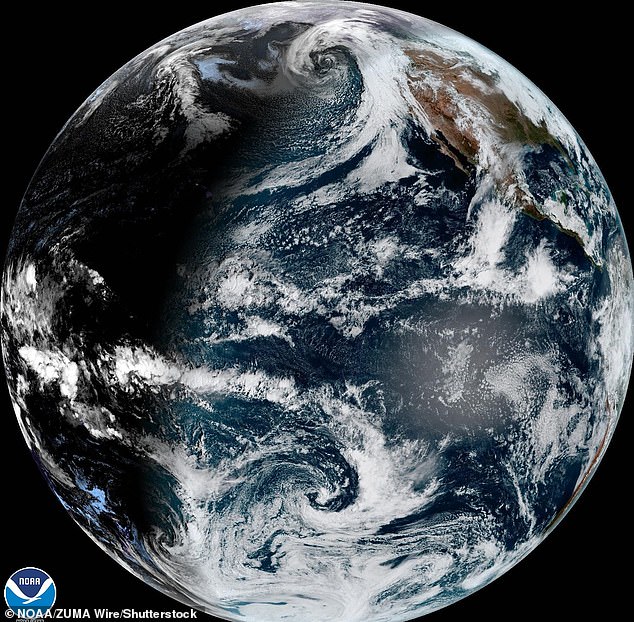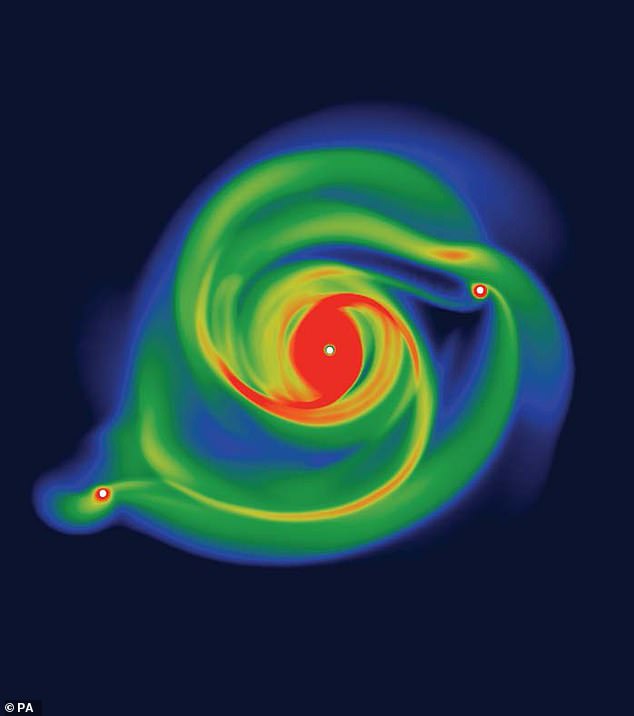The Earth may not always have been a sphere! Scientists think the planet originally resembled a Smartie
It may be common knowledge that the Earth is round, but scientists now say this may not always have been the case.
Instead of being spherical like a Maltese, scientists think the Earth was flatter ‘like a Smartie’ very early in its life.
Scientists previously assumed that “protoplanets” – very young planets that recently formed around stars – would be spheres.
To put this assumption to the test, researchers from the University of Central Lancashire simulated how planets might form from the gas disks around stars.
This showed that newly formed planets, instead of being round, are actually squashed.
Researchers now believe that planets may not be spherical when they first form, but are actually oblate shapes called “oblate spheroids.” This simulation shows a protoplanet seen from the top (left) and from the side (right)

The Earth itself is not perfectly round, as it is flattened by about 0.3 percent at the poles. But the researchers say protoplanets can be crushed by about 90 percent
This is the first time scientists have ever looked at the 3D shape of newborn planets in their simulation.
Dr. Dimitris Stamatellos, co-author of the paper, says: ‘We were very surprised that they turned out to be oblate spheroids, which looked quite similar to Smarties!
‘We have been studying planet formation for a long time, but never before had we thought about checking the shape of the planets as they form in the simulations.
“We always assumed they were spherical.”
Most of the planets we can observe are spheres, or at least very close to spheres.
Earth is flattened at the poles by about 0.3 percent, Jupiter by about 6 percent, and Saturn by as much as 10 percent.
But scientists now believe that protoplanets are about 90 percent oblate.
The protoplanet phase is believed to last between the first 1-5 million years of a planet’s existence.
Since the Earth is about 4.5 billion years old, it would have had a Smartie shape for a very small part of its early history.

Scientists had previously assumed that young planets would be spheres, but instead they were surprised to find that they are oblate spheroids, like smarties (pictured) (stock image)

The researchers simulated how planets form according to the disk instability theory. This simulation shows how the gas disk around a young star suddenly collapses into planets
There are currently two leading theories about how protoplanets form.
The first, as lead researcher Dr Adam Fenton explains, is called the ‘core accretion’ theory.
This theory claims that planets form through the “gradual growth of dust grains that stick together to form larger and larger objects over long timescales.”
The second theory is the disk instability theory, which claims that planets form in a relatively short time due to the rapid disintegration of the rotating gas disk around a young star.
Dr. Fenton says: ‘This theory is attractive due to the fact that large planets can form very quickly at large distances from their host star, which explains some exoplanet observations.’
Based on the predictions of this theory, the researchers simulated the formation of gas planets around a young star.
Dr. Fenton says the computation was extremely demanding, requiring half a million CPU hours at the UK’s DiRAC High Performance Computing Facility.
Once the simulation was complete, however, the researchers were surprised to discover that the protoplanets were not spheres after all.
In their article, which will be published in Astronomy and Astrophysics Lettersthe researchers suggest that the planets become flat because they form within a rotating disk.
Just as a chef spins a ball of pizza dough, the force of the spinning stretches and flattens the young planet.
The researchers think that planets only become spherical later, because gas and other matter ends up more quickly at their north and south poles than at the equator.

These results could answer the question of how planets form. If researchers don’t find spherical protoplanets like the ones in this artist’s impression, it would be good evidence that they form through disk instability
These predictions may one day help solve the question of how planets form.
Observations of protoplanets are still very rare and have only become possible in recent years.
However, the researchers expect that the flattening of protoplanets will be visible through telescopes.
They write: ‘We expect that this could lead to a strong change in the observed properties of protoplanets with the viewing angle that must be taken into account when interpreting observations.’
But according to the nuclear accretion theory, protoplanets would still be spherical.
This means that if researchers can observe oblate protoplanets, it would be good evidence for the currently unfavorable disk instability theory.
The researchers are currently improving the calculation model to compare the results with future observations from the James Webb Space Telescope.
